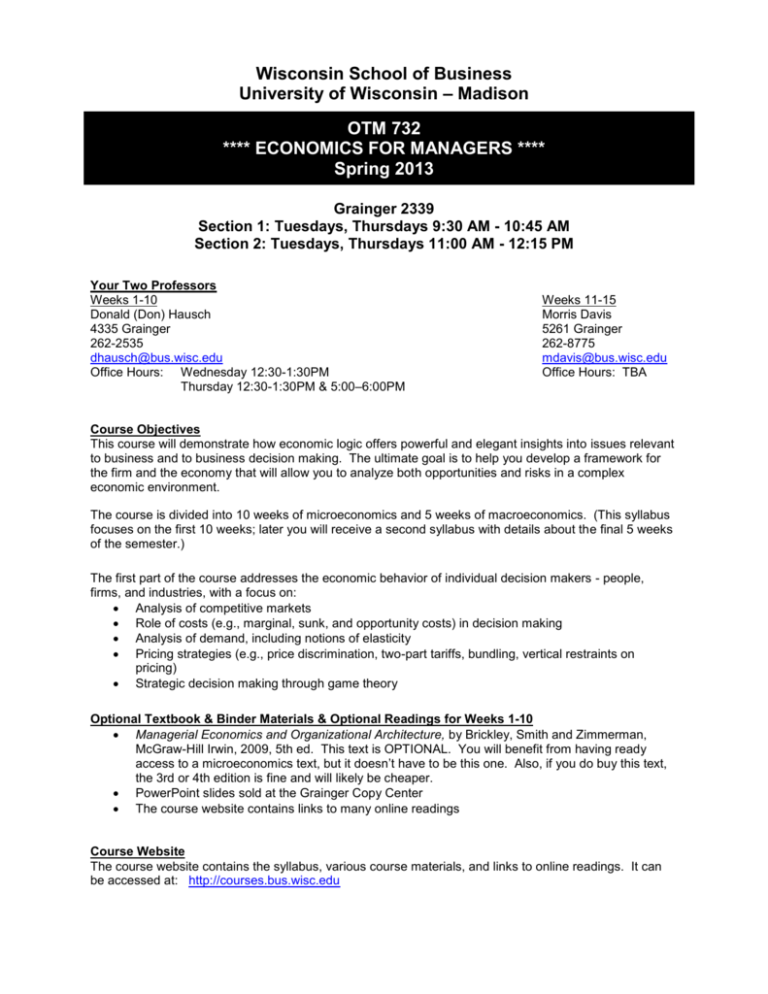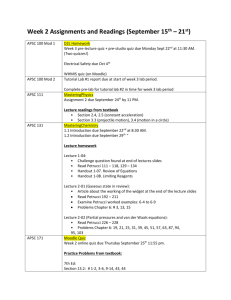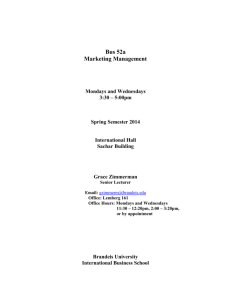part i: economics for managers - University of Wisconsin
advertisement

Wisconsin School of Business University of Wisconsin – Madison OTM 732 **** ECONOMICS FOR MANAGERS **** Spring 2013 Grainger 2339 Section 1: Tuesdays, Thursdays 9:30 AM - 10:45 AM Section 2: Tuesdays, Thursdays 11:00 AM - 12:15 PM Your Two Professors Weeks 1-10 Donald (Don) Hausch 4335 Grainger 262-2535 dhausch@bus.wisc.edu Office Hours: Wednesday 12:30-1:30PM Thursday 12:30-1:30PM & 5:00–6:00PM Weeks 11-15 Morris Davis 5261 Grainger 262-8775 mdavis@bus.wisc.edu Office Hours: TBA Course Objectives This course will demonstrate how economic logic offers powerful and elegant insights into issues relevant to business and to business decision making. The ultimate goal is to help you develop a framework for the firm and the economy that will allow you to analyze both opportunities and risks in a complex economic environment. The course is divided into 10 weeks of microeconomics and 5 weeks of macroeconomics. (This syllabus focuses on the first 10 weeks; later you will receive a second syllabus with details about the final 5 weeks of the semester.) The first part of the course addresses the economic behavior of individual decision makers - people, firms, and industries, with a focus on: Analysis of competitive markets Role of costs (e.g., marginal, sunk, and opportunity costs) in decision making Analysis of demand, including notions of elasticity Pricing strategies (e.g., price discrimination, two-part tariffs, bundling, vertical restraints on pricing) Strategic decision making through game theory Optional Textbook & Binder Materials & Optional Readings for Weeks 1-10 Managerial Economics and Organizational Architecture, by Brickley, Smith and Zimmerman, McGraw-Hill Irwin, 2009, 5th ed. This text is OPTIONAL. You will benefit from having ready access to a microeconomics text, but it doesn’t have to be this one. Also, if you do buy this text, the 3rd or 4th edition is fine and will likely be cheaper. PowerPoint slides sold at the Grainger Copy Center The course website contains links to many online readings Course Website The course website contains the syllabus, various course materials, and links to online readings. It can be accessed at: http://courses.bus.wisc.edu Grading You will receive one final letter grade for OTM 732, and it will be weighted 2/3 on Part I (micro) and 1/3 on Part II (macro). Professor Davis will explain his grading for Part II later in the semester. The requirements and grading weights for the micro part are: PART I January 22 – April 4 (2/3 of OTM 732 grade) 2 Team Homeworks Quiz I Quiz II In-class exercises Optional out-of-class project 20% 35% 40% 5% replaces lowest 10% above Historically, the distribution of letter grades in this course has been roughly: A 30-35% AB 30-35% B 30-35% below B 0-8% Homework There are two team homework assignments over the first 10 weeks of the course. Solutions are due on THURSDAY, FEBRUARY 14 and THURSDAY, MARCH 21. Please submit one HARD COPY of your team’s solutions on the due date, either to me at the start of class or to my mailbox across from GRAINGER 5249 by noon. No credit is given for late homework since I post solutions on the due date. Quizzes For the first 10 weeks of the course, there are two in-class quizzes on THURSDAY, FEBRUARY 21 and THURSDAY, APRIL 4. I will attach a list of the relevant formulas and equations to each quiz. In-Class Exercises There will be several very short in-class exercises as a way to introduce & practice some of the course topics. You need to be in attendance to get credit for an exercise. For each of you, I will discard your exercise with the lowest score. Optional Individual/Group Out-of-class Project The quizzes and homework assignments use constructed problems of a quantitative Q&A nature. This approach can be an effective way to experience, practice, and learn the concepts from class, but there are other approaches that might be more effective and/or more relevant for some of you. For example: 1) Mini consulting project for an organization (probably local) pricing analysis for a service or product market analysis for a new product cost analysis of a new piece of equipment or activity 2) Economic analysis of a current business issue, such as a proposed regulation in an industry a new product’s entry into a market 3) Artistic/creative representation of an economic concept from class, using video, dance, song, photography, or whatever seems appropriate. These are just examples of possible projects and I am open to discussing other ideas. A few guidelines on the projects: - You must get approval from me on the project and the deliverables. (This will ensure that the work will be appropriate in terms of concept and scale.) - The project cannot be one that was or will be used for another course. (Or, at least, let’s discuss.) - You can work alone or in a group of up to 3 students. (The scale of the project and deliverables will vary with the group size.) - The grade on the project will replace the lowest 10% of your grade in the required deliverables of the course. So, for example, if your lowest percent grade was on quiz II (which counts for 40% of your grade), then the project will replace one quarter of your quiz II grade (10%/40% = 1/4). Laptop Policy Please do not use your laptop during class. If there is a reason to individually deviate from this policy, please talk with me. Honor Code You are expected to uphold the MBA Honor Code that you signed during the MBA Experience. The specific ways that the MBA Honor Code applies in this class are: HOMEWORK The two homeworks are TEAM assignments. The team is the team assigned by the program. You are expected to work cooperatively within your team on the assignments, with everyone involved in the work. You are invited to discuss the assignments with me; indeed, you are encouraged to do so. However, you must NOT discuss the homework with anyone else, including members of other teams, people who took this class in the past, friends, etc. Some of the homework problems this semester may have been assigned in previous semesters. You may NOT access any solutions from previous semesters. QUIZZES Exams are closed-book, closed-notes, and strictly individual efforts. The best way to deal with questions or clarification on how to abide by the MBA Honor Code in OTM 732 is to talk with me. Please don’t hesitate to do that. PART I: ECONOMICS FOR MANAGERS The schedule for Part I of Economics for Managers is below. The schedule for Part II (macroeconomics and taught by Professor Morris Davis) will be provided later. The readings that are listed below refer to the OPTIONAL textbook, Managerial Economics and Organizational Architecture. Please check out the online version of the syllabus at http://courses.bus.wisc.edu to read optional articles (most are online) that provide examples and perspectives on the topics that we cover in class. Part I of the course begins with a thorough treatment of classical supply & demand analysis. We then investigate the firm's responses to external forces, such as tariffs, regulations, changes in competition, new input prices, and so on, followed by a more careful investigation of demand, with a focus on the effect of price on revenue. We also identify the relevant costs for decision making, which is important for understanding how firms should respond to changes in their environment. Bringing together the firm’s demand for its product and its costs, we next address optimal pricing strategies for firms with market power. Shifting from studying a firm in isolation, we end the course with a game theoretic analysis of interdependent multi-firm decision making, providing further insights into the performance of firms and industries. SCHEDULE January 22, 24, 29, 31, February 5 How Do Markets Work? Learning Outcomes: Understand the competitive supply and demand model, when it is relevant, and its equilibrium predictions and efficiency properties Understand the nature of the demand and the relation between the supply curve and marginal cost Understand how to incorporate “shocks” and interventions (e.g., protectionism, price controls) into this market model Understand notion of externalities, their effect on the market, and possible responses Textbook Readings: 5th edition - Ch 1 (review quickly), Ch 2 (review quickly pg. 16-43), Ch 3 (pg. 60-94) 4th edition - Ch 1 (review quickly), Ch 2 (review quickly pg. 14-40), Ch 3 (pg. 55-90) 3rd edition - Ch 1 (review quickly), Ch 3 (review quickly pg. 14-39), Ch 3 (pg. 42-68) February 7, 12 How Do Our Customers Value Our Products? Learning Outcomes: Understand demand function and demand curve Facility with the notion of elasticity of price, income, advertising, etc. Understand how price elasticity predicts the effect on revenue and profit of price changes Understand the connections among total revenue, average revenue and marginal revenue Be able to calculate the arc price elasticity Textbook Readings: 5th edition - Ch 4 (pg. 106-136) 4th edition - Ch 4 (pg. 96-122) 3rd edition - Ch 4 (pg. 74-102) February 14, 19 What are the Relevant Cost Measures for Decision Making? Learning Outcomes: Understand concepts of total cost, fixed cost, variable cost, marginal cost, average cost, average variable cost, average fixed cost, and how the all relate. Understand sunk costs Understand accounting (historical) costs and opportunity costs, and how they are different Understand how these various cost concepts are relevant for decision making Textbook Readings: 5th edition - Ch 5 (pg. 154-165) 4th edition - Ch 5 (pg. 140-149) 3rd edition - Ch 5 (pg. 117-126) HOMEWORK #1 due on February 14 February 21 ********** QUIZ 1 *********** How Do Markets Work? How Do Our Customers Value Our Products? What are the Relevant Cost Measures for Decision Making? February 26, 28, March 5, 7, 12 Market Power and Pricing Learning Outcomes: Understand the distinction between competitive markets where the market establishes prices and markets in which the seller is a price maker Be able to explain some sources of market power that allow the seller to be a price maker. Understand the gains to trade that are available to the buyer and seller, and that the seller attempts to realize through its pricing strategy Understand “standard” pricing, how it is based on MC and MR, its efficiency properties, and its relation to cost-plus pricing Understand the opportunities for more sophisticated pricing strategies to generate higher profits than “standard” pricing Have a working understanding of two-part tariffs, price discrimination, versioning, bundling, and vertical restraints on pricing Textbook Readings: 5th edition - Ch 6 (pg. 188-190), Ch 7 4th edition - Ch 6 (pg. 170-171), Ch 7 3rd edition - Ch 6 (pg. 146-147), Ch 7 March 14, 19, 21, April 2 Game Theory & Oligopoly Learning Outcomes: Understand that game theory deals with interdependent decision problems and be able to explain or offer examples of how that may lead to different predictions Understand the following solutions concepts: predictions based on strictly dominant strategies, Nash equilibrium, subgame perfect equilibrium Facility with developing matrix versions of games and sequential versions of games Understand the prisoner’s dilemma, be able to write down a matrix version of a prisoner’s dilemma game, identify its Nash equilibrium, be able to explain the counterintuitive nature of the Nash equilibrium, and be able to offer examples of settings where this model offers insights and direction Understand how and why oligopoly settings have prisoner’s dilemma characteristics, both when prices are strategic variables and when quantities are strategic variables Understand the inherent instability of cartels Understand game theory’s insights into commitment, entry deterrence, and first/second mover issues Textbook Readings: 5th edition - Ch 6 (pg. 191-200), Ch 9 4th edition - Ch 6 (pg. 172-181), Ch 9 3rd edition - Ch 6 (pg. 148-156), Ch 9 HOMEWORK #2 due on March 21 April 4 ***** QUIZ 2 ***** Market Power and Pricing Game Theory & Oligopoly








